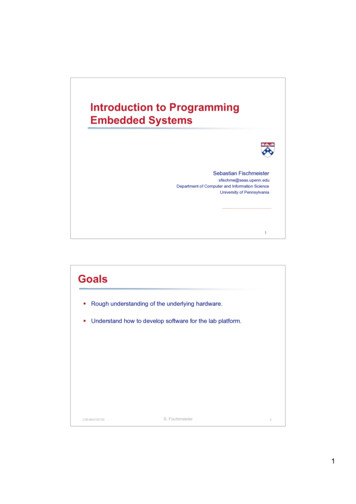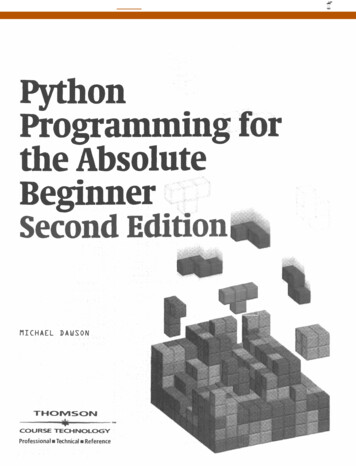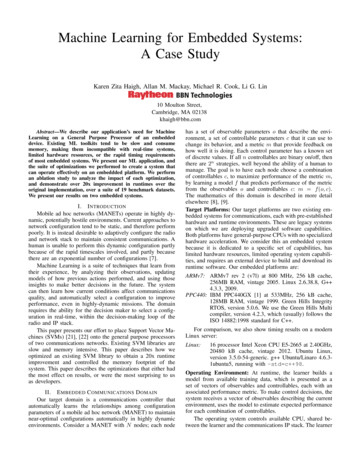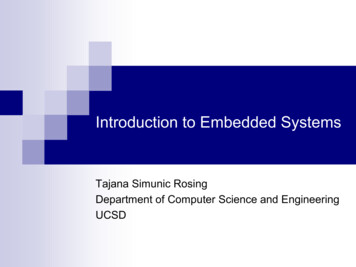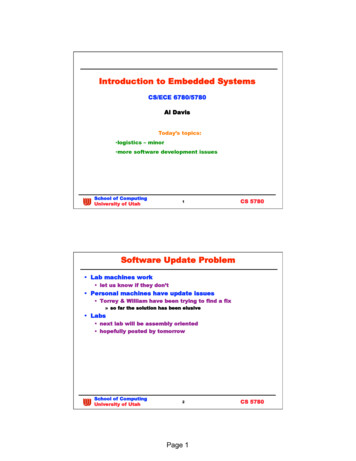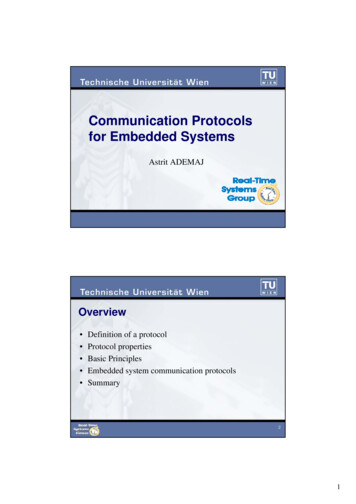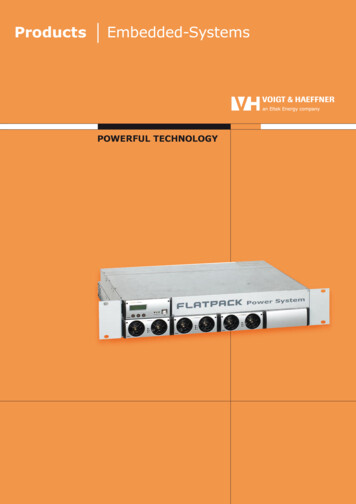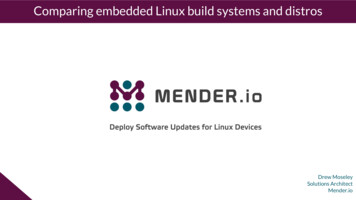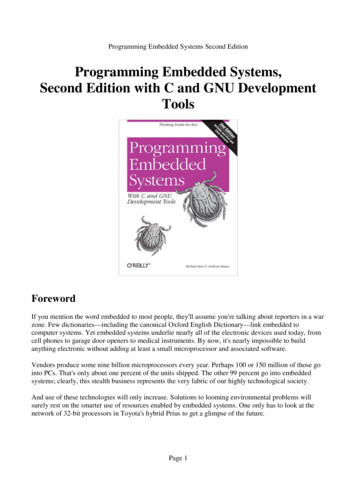
Transcription
Programming Embedded Systems Second EditionProgramming Embedded Systems,Second Edition with C and GNU DevelopmentToolsForewordIf you mention the word embedded to most people, they'll assume you're talking about reporters in a warzone. Few dictionaries—including the canonical Oxford English Dictionary—link embedded tocomputer systems. Yet embedded systems underlie nearly all of the electronic devices used today, fromcell phones to garage door openers to medical instruments. By now, it's nearly impossible to buildanything electronic without adding at least a small microprocessor and associated software.Vendors produce some nine billion microprocessors every year. Perhaps 100 or 150 million of those gointo PCs. That's only about one percent of the units shipped. The other 99 percent go into embeddedsystems; clearly, this stealth business represents the very fabric of our highly technological society.And use of these technologies will only increase. Solutions to looming environmental problems willsurely rest on the smarter use of resources enabled by embedded systems. One only has to look at thenetwork of 32-bit processors in Toyota's hybrid Prius to get a glimpse of the future.Page 1
Programming Embedded Systems Second EditionThough prognostications are difficult, it is absolutely clear that consumers will continue to demand everbrainier products requiring more microprocessors and huge increases in the corresponding software.Estimates suggest that the firmware content of most products doubles every 10 to 24 months. While thedemand for more code is increasing, our productivity rates creep up only slowly. So it's also clear thatthe industry will need more embedded systems people in order to meet the demand.What skills will these people need? In the PC world, one must be a competent C/C programmer. Butembedded developers must have a deep understanding of both the programming languages and thehardware itself; no one can design, code, and test an interrupt service routine, for instance, withoutknowing where the interrupts come from, how the hardware prioritizes them, the tricks behind servicingthat hardware, and machine-level details about saving and preserving the system's context. A firmwaredeveloper must have detailed insight into the hardware implementation of his system's peripheralsbefore he can write a single line of driver code.In the PC world, the magic of the hardware is hidden behind an extensive API. In an embedded system,that API is always written by the engineers that are developing the product.In this book, Michael Barr and Anthony Massa show how the software and hardware form a synergisticgestalt. They don't shy away from the intricacies of interrupts and I/O, or priority inversion and mutexes.The authors appropriately demonstrate building embedded systems using a variety of open source tools,including the GNU compiler suite, which is a standard tool widely used in this industry. eCos and Linux,both free/open source products, are used to demonstrate small and large operating systems.The original version of this book used an x86 target board, which has been replaced in this edition by anARM-based product. Coincidently, as this volume was in production, Intel made an end-of-lifeannouncement for all of its embedded x86 processors. Readers can be assured that the ARM will bearound for a very long time, as it's supported by an enormous infrastructure of vendors.The hardware is inexpensive and easily available; the software is free. Together they represent themainstream of embedded systems development. Readers can be sure they'll use these tools in the future.Buy the development kit, read the book, and execute the examples. You'll get the hands-on experiencethat employers demand: building and working with real embedded applications.PrefaceFirst figure out why you want the students to learn the subject and what you want them to know, and themethod will result more or less by common sense.Richard FeynmanEmbedded software is in almost every electronic device in use today. There is software hidden awayinside our watches, DVD players, mobile phones, antilock brakes, and even a few toasters. The militaryuses embedded software to guide missiles, detect enemy aircraft, and pilot UAVs. CommunicationPage 2
Programming Embedded Systems Second Editionsatellites, deep-space probes, and many medical instruments would've been nearly impossible to createwithout it.Someone has to write all that software, and there are tens of thousands of electrical engineers, computerscientists, and other professionals who actually do. We are two of them, and we know from our personalexperiences just how hard it can be to learn the craft.Each embedded system is unique, and the hardware is highly specialized to the application domain. As aresult, embedded systems programming can be a widely varying experience and can take years tomaster. However, one common denominator across almost all embedded software development is theuse of the C programming language. This book will teach you how to use C in any embedded system.Even if you already know how to write embedded software, you can still learn a lot from this book. Inaddition to learning how to use C more effectively, you'll also benefit from the detailed explanations andsource code associated with common embedded software problems. Among the advanced topics coveredin the book are memory testing and verification, device driver design and implementation, real-timeoperating system internals, and code optimization techniques.Why We Wrote This BookEach year, globally, approximately one new processor is manufactured per person. That's more than sixbillion new processors each year, fewer than two percent of which are the Pentiums and PowerPCs at theheart of new personal computers. You may wonder whether there are really that many computerssurrounding us. But we bet that within five minutes you can probably spot dozens of products in yourown home that contain processors: televisions, stereos, MP3 players, coffee makers, alarm clocks,VCRs, DVD players, microwaves, dishwashers, remote controls, bread machines, digital watches, andso on. And those are just the personal possessions—many more such devices are used at work. The factthat every one of those products contains not only a processor, but also software, is the impetus for thisbook.One of the hardest things about this subject is knowing when to stop writing. Each embedded system isunique, and we have therefore learned that there is an exception to every rule. Nevertheless, we havetried to boil the subject down to its essence and present the things that programmers definitely need toknow about embedded systems.Intended AudienceThis is a book about programming embedded systems in C. As such, it assumes that the reader alreadyhas some programming experience and is at least familiar with the syntax of the C language. It alsohelps if you have some familiarity with basic data structures, such as linked lists. The book does notassume that you have a great deal of knowledge about computer hardware, but it does expect that youare willing to learn a little bit about hardware along the way. This is, after all, a part of the job of anembedded programmer.While writing this book, we had two types of readers in mind. The first reader is a beginner—much aswe were once. He has a background in computer science or engineering and a few years of programmingPage 3
Programming Embedded Systems Second Editionexperience. The beginner is interested in writing embedded software for a living but is not sure just howto get started. After reading the first several chapters, he will be able to put his programming skills towork developing simple embedded programs. The rest of the book will act as a reference for the moreadvanced topics encountered in the coming months and years of his career.The second reader is already an embedded systems programmer. She is familiar with embeddedhardware and knows how to write software for it but is looking for a reference book that explains keytopics. Perhaps the embedded systems programmer has experience only with assembly languageprogramming and is relatively new to C. In that case, the book will teach her how to use the C languageeffectively in an embedded system, and the later chapters will provide advanced material on real-timeoperating systems, peripherals, and code optimizations.Whether you fall into one of these categories or not, we hope this book provides the information you arelooking for in a format that is friendly and easily accessible.OrganizationThe book contains 14 chapters and 5 appendixes. The chapters can be divided quite nicely into twoparts. The first part consists of Chapters 1 through 5 and is intended mainly for newcomers to embeddedsystems. These chapters should be read in their entirety and in the order that they appear. This will bringyou up to speed quickly and introduce you to the basics of embedded software development. Aftercompleting Chapter 5, you will be ready to develop small pieces of embedded software on your own.The second part of the book consists of Chapters 6 through 14 and discusses advanced topics that are ofinterest to inexperienced and experienced embedded programmers alike. These chapters are mostly selfcontained and can be read in any order. In addition, Chapters 6 through 12 contain example programsthat might be useful to you on a future embedded software project.Chapter 1, IntroductionExplains the field of embedded programming and lays out the parameters of the book, includingthe reference hardware used for examplesChapter 2, Getting to Know the HardwareShows how to explore the documentation for your hardware and represent the components youneed to interact with in CChapter 3, Your First Embedded ProgramPage 4
Programming Embedded Systems Second EditionCreates a simple blinking light application that illustrates basic principles of embeddedprogrammingChapter 4, Compiling, Linking, and LocatingGoes over the ways that embedded systems differ from conventional computer systems duringprogram building steps, covering such issues as cross-compilersChapter 5, Downloading and DebuggingIntroduces the tools you'll need in order to iron out problems in both hardware and softwareChapter 6, MemoryDescribes the different types of memory that developers choose for embedded systems and theissues involved in using each typeChapter 7, PeripheralsIntroduces the notion of a device driver, along with other coding techniques for working withdevicesChapter 8, InterruptsCovers this central area of working with peripheralsChapter 9, Putting It All TogetherCombines the concepts and code from the previous chapter with convenience functions and amain program, to create a loadable, testable applicationChapter 10, Operating SystemsPage 5
Programming Embedded Systems Second EditionIntroduces common operating system concepts, including tasks (or threads) and synchronizationmechanisms, along with the reasons for adding a real-time operating systemChapter 11, eCos ExamplesShows how to use some features of the eCos real-time operating systemChapter 12, Embedded Linux ExamplesAccomplishes the same task as the previous chapter, but for the embedded Linux operatingsystemChapter 13, Extending FunctionalityDescribes options for adding buses, networking, and other communication features to a systemChapter 14, Optimization TechniquesDescribes ways to decrease code size, reduce memory use, and conserve powerAppendix A, The Arcom VIPER-Lite Development KitDescribes the board used for the examples in this book and how to order one for yourselfAppendix B, Setting Up Your Software Development EnvironmentGives instructions for loading the software described in this book on your host Windows orLinux computerAppendix C, Building the GNU Software ToolsShows you how to compile the GNU development toolsPage 6
Programming Embedded Systems Second EditionAppendix D, Setting Up the eCos Development EnvironmentShows you how to build an eCos library appropriate for your embedded system so you cancompile programs to run on your systemAppendix E, Setting Up the Embedded Linux Development EnvironmentDescribes how to install the embedded Linux tools for your Arcom system and build and run aprogram on itThroughout the book, we have tried to strike a balance between specific examples and generalinformation. Whenever possible, we have eliminated minor details in the hope of making the book morereadable. You will gain the most from the book if you view the examples, as we do, primarily as toolsfor understanding important concepts. Try not to get bogged down in the details of any one circuit boardor chip. If you understand the general C programming concepts, you should be able to apply them to anyembedded system you encounter.To focus the book's example code on specific concepts, we intentionally left it incomplete—forexample, by eliminating certain include files and redundant variable declarations. For complete detailsabout the code, refer to the full example source code on the book's web site.Conventions, Typographical and OtherwiseThe following typographical conventions are used throughout the book:ItalicIndicates names of files, programs, methods, and options when they appear in the body of aparagraph. Italic is also used for emphasis and to introduce new terms.Constant WidthIn examples, indicates the contents of files and the output of commands. In regular text, this styleindicates keywords, functions, variable names, classes, objects, parameters, and other codesnippets.Constant Width BoldPage 7
Programming Embedded Systems Second EditionIndicates commands and options to be typed literally. This style is used in examples only.Constant Width Bold ItalicIndicates text to be replaced with user values; for example, a filename on your system. This styleis used in examples only.This symbol is used to indicate a tip, suggestion, or general note.This symbol is used to indicate a warning.Other conventions relate to gender and roles. With respect to gender, we have purposefully used both"he" and "she" throughout the book. With respect to roles, we have occasionally distinguished betweenthe tasks of hardware engineers, embedded software engineers, and application programmers. But thesetitles refer only to roles played by individual engineers, and it should be noted that it can and often doeshappen that a single individual fills more than one of these roles on an embedded-project team.Obtaining the Examples OnlineThis book includes many source code listing, and all but the most trivial snippets are available online.These examples are organized by chapter number and include build instructions (makefiles) to help yourecreate each of the executables. The complete archive is available athttp://examples.oreilly.com/embsys2.Using Code ExamplesThis book is here to help you get your job done. In general, you may use the code in this book in yourprograms and documentation. You do not need to contact us for permission unless you're reproducing asignificant portion of the code. For example, writing a program that uses several chunks of code fromthis book does not require permission. Selling or distributing a CD-ROM of examples from O'Reillybooks does require permission. Answering a question by citing this book and quoting example code doesnot require permission. Incorporating a significant amount of example code from this book into yourproduct's documentation does require permission.We appreciate, but do not require, attribution. An attribution usually includes the title, author, publisher,and ISBN. For example: "Programming Embedded Systems with C and GNU Development Tools,Second Edition, by Michael Barr and Anthony Massa. Copyright 2007 O'Reilly Media, Inc., 978-0-59600983-0."Page 8
Programming Embedded Systems Second EditionIf you feel your use of code examples falls outside fair use or the permission given above, feel free tocontact us at permissions@oreilly.com.Chapter 1. IntroductionI think there is a world market for maybe five computers.—Thomas Watson, Chairman of IBM, 1943There is no reason anyone would want a computer in their home.—Ken Olson, President of Digital Equipment Corporation, 1977One of the more surprising developments of the last few decades has been the ascendance of computersto a position of prevalence in human affairs. Today there are more computers in our homes and officesthan there are people who live and work in them. Yet many of these computers are not recognized assuch by their users. In this chapter, we'll explain what embedded systems are and where they are found.We will also introduce the subject of embedded programming and discuss what makes it a unique formof software programming. We'll explain why we have selected C as the language for this book anddescribe the hardware used in the examples.1.1. What Is an Embedded System?An embedded system is a combination of computer hardware and software—and perhaps additionalparts, either mechanical or electronic—designed to perform a dedicated function. A good example is themicrowave oven. Almost every household has one, and tens of millions of them are used every day, butvery few people realize that a computer processor and software are involved in the preparation of theirlunch or dinner.The design of an embedded system to perform a dedicated function is in direct contrast to that of thepersonal computer. It too is comprised of computer hardware and software and mechanical components(disk drives, for example). However, a personal computer is not designed to perform a specific function.Rather, it is able to do many different things. Many people use the term general-purpose computer tomake this distinction clear. As shipped, a general-purpose computer is a blank slate; the manufacturerdoes not know what the customer will do with it. One customer may use it for a network file server,another may use it exclusively for playing games, and a third may use it to write the next great Americannovel.Frequently, an embedded system is a component within some larger system. For example, modern carsand trucks contain many embedded systems. One embedded system controls the antilock brakes, anothermonitors and controls the vehicle's emissions, and a third displays information on the dashboard. Someluxury car manufacturers have even touted the number of processors (often more than 60, including onein each headlight) in advertisements. In most cases, automotive embedded systems are connected by acommunications network.Page 9
Programming Embedded Systems Second EditionIt is important to point out that a general-purpose computer interfaces to numerous embedded systems.For example, a typical computer has a keyboard and mouse, each of which is an embedded system.These peripherals each contain a processor and software and is designed to perform a specific function.Another example is a modem, which is designed to send and receive digital data over an analogtelephone line; that's all it does. And the specific function of other peripherals can each be summarizedin a single sentence as well.The existence of the processor and software in an embedded system may be unnoticed by a user of thedevice. Such is the case for a microwave oven, MP3 player, or alarm clock. In some cases, it would evenbe possible to build a functionally equivalent device that does not contain the processor and software.This could be done by replacing the processor-software combination with a custom integrated circuit(IC) that performs the same functions in hardware. However, the processor and software combinationtypically offers more flexibility than a hardwired design. It is generally much easier, cheaper, and lesspower intensive to use a processor and software in an embedded system.1.1.1. History and FutureGiven the definition of embedded systems presented earlier in this chapter, the first such systems couldnot possibly have appeared before 1971. That was the year Intel introduced the world's first single-chipmicroprocessor. This chip, the 4004, was designed for use in a line of business calculators produced bythe Japanese company Busicom. In 1969, Busicom asked Intel to design a set of custom integratedcircuits, one for each of its new calculator models. The 4004 was Intel's response. Rather than designcustom hardware for each calculator, Intel proposed a general-purpose circuit that could be usedthroughout the entire line of calculators. This general-purpose processor was designed to read andexecute a set of instructions—software—stored in an external memory chip. Intel's idea was that thesoftware would give each calculator its unique set of features and that this design style would drivedemand for its core business in memory chips.The microprocessor was an overnight success, and its use increased steadily over the next decade. Earlyembedded applications included unmanned space probes, computerized traffic lights, and aircraft flightcontrol systems. In the 1980s and 1990s, embedded systems quietly rode the waves of themicrocomputer age and brought microprocessors into every part of our personal and professional lives.Most of the electronic devices in our kitchens (bread machines, food processors, and microwave ovens),living rooms (televisions, stereos, and remote controls), and workplaces (fax machines, pagers, laserprinters, cash registers, and credit card readers) are embedded systems; over 6 billion newmicroprocessors are used each year. Less than 2 percent (or about 100 million per year) of thesemicroprocessors are used in general-purpose computers.It seems inevitable that the number of embedded systems will continue to increase rapidly. Already thereare promising new embedded devices that have enormous market potential: light switches andthermostats that are networked together and can be controlled wirelessly by a central computer,intelligent air-bag systems that don't inflate when children or small adults are present, medicalmonitoring devices that can notify a doctor if a patient's physiological conditions are at critical levels,and dashboard navigation systems that inform you of the best route to your destination under currenttraffic conditions. Clearly, individuals who possess the skills and the desire to design the next generationof embedded systems will be in demand for quite some time.Page 10
Programming Embedded Systems Second Edition1.1.2. Real-Time SystemsOne subclass of embedded systems deserves an introduction at this point. A real-time system has timingconstraints. The function of a real-time system is thus partly specified in terms of its ability to makecertain calculations or decisions in a timely manner. These important calculations or activities havedeadlines for completion.The crucial distinction among real-time systems lies in what happens if a deadline is missed. Forexample, if the real-time system is part of an airplane's flight control system, the lives of the passengersand crew may be endangered by a single missed deadline. However, if instead the system is involved insatellite communication, the damage could be limited to a single corrupt data packet (which may or maynot have catastrophic consequences depending on the application and error recovery scheme). The moresevere the consequences, the more likely it will be said that the deadline is "hard" and thus, that thesystem is a hard real-time system. Real-time systems at the other end of this continuum are said to have"soft" deadlines—a soft real-time system. Figure 1-1 shows some examples of hard and soft real-timesystems.Figure 1-1. A range of example real-time systemsReal-time system design is not simply about speed. Deadlines for real-time systems vary; one deadlinemight be in a millisecond, while another is an hour away. The main concern for a real-time system isthat there is a guarantee that the hard deadlines of the system are always met. In order to accomplish thisthe system must be predictable.The architecture of the embedded software, and its interaction with the system hardware, play a key rolein ensuring that real-time systems meet their deadlines. Key software design issues include whetherpolling is sufficient or interrupts should be used, and what priorities should be assigned to the varioustasks and interrupts. Additional forethought must go into understanding the worst-case performancerequirements of the specific system activities.All of the topics and examples presented in this book are applicable to the designers of real-timesystems. The designer of a real-time system must be more diligent in his work. He must guaranteereliable operation of the software and hardware under all possible conditions. And, to the degree thathuman lives depend upon the system's proper execution, this guarantee must be backed by engineeringcalculations and descriptive paperwork.Page 11
Programming Embedded Systems Second Edition1.2. Variations on a ThemeUnlike software designed for general-purpose computers, embedded software cannot usually be run onother embedded systems without significant modification. This is mainly because of the incrediblevariety of hardware in use in embedded systems. The hardware in each embedded system is tailoredspecifically to the application, in order to keep system costs low. As a result, unnecessary circuitry iseliminated and hardware resources are shared wherever possible.In this section, you will learn which hardware features are common across all embedded systems andwhy there is so much variation with respect to just about everything else. Later in the book, we will lookat some techniques that can be used to minimize the impact of software changes so they are not neededthroughout all layers of the software.1.2.1. Common System ComponentsBy definition, all embedded systems contain a processor and software, but what other features do theyhave in common? Certainly, in order to have software, there must be a place to store the executable codeand temporary storage for runtime data manipulation. These take the form of read-only memory (ROM)and random access memory (RAM), respectively; most embedded systems have some of each. If only asmall amount of memory is required, it might be contained within the same chip as the processor.Otherwise, one or both types of memory reside in external memory chips.All embedded systems also contain some type of inputs and outputs. For example, in a microwave oven,the inputs are the buttons on the front panel and a temperature probe, and the outputs are the humanreadable display and the microwave radiation. The outputs of the embedded system are almost always afunction of its inputs and several other factors (elapsed time, current temperature, etc.). The inputs to thesystem usually take the form of sensors and probes, communication signals, or control knobs andbuttons. The outputs are typically displays, communication signals, or changes to the physical world.See Figure 1-2 for a general example of an embedded system.Figure 1-2. A generic embedded systemPage 12
Programming Embedded Systems Second EditionWith the exception of these few common features, the rest of the embedded hardware is usually uniqueand, therefore, requires unique software. This variation is the result of many competing design criteria.The software for the generic embedded system shown in Figure 1-2 varies depending on thefunctionality needed. The hardware is the blank canvas, and the software is the paint that we add inorder to make the picture come to life. Figure 1-3 gives just a couple of possible high-level diagramsthat could be implemented on such a generic embedded system.Figure 1-3. (a) Basic embedded software diagram and (b) a more complex embedded softwarediagramBoth the basic embedded software diagram in Figure 1-3(a) and the more complex embedded softwarediagram in Figure 1-3(b) contain very similar blocks. The hardware block is common in both diagrams.The device drivers are embedded software modules that contain the functionality to operate theindividual hardware devices. The reason for the device driver software is to remove the need for theapplication to know how to control each piece of hardware. Each individual device driver wouldtypically need to know only how to control its hardware device. For instance, for a microwave oven,separate device drivers control the keypad, display, temperature probe, and radiation control.If more functionality is required, it is sometimes necessary to include additional layers in the embeddedsoftware to assist with this added functionality. In this example, the complex diagram includes a realtime operating system (RTOS) and a networking stack. The RTOS can help the programmer separate theapplication's functionality into distinct tasks for better organization of the application software and amore responsive system. We will investigate the use of an RTOS later in this book. The network stackPage 13
Programming Embedded Systems Second Editionalso adds to the functionality of the basic embedded system; a microwave oven might use it to pop up amessage on your desktop computer when your lunch is ready.The responsibilities of the application software layer is the same in both the basic and the complexembedded software diagrams. In a microwave oven, the application processes the different inputs andcontrols the outputs based on what the user commands it to do.You'll notice that the software in Figure 1-3 is represented by discrete blocks stacked on top of oneanother with fixed borders. This is done deliberately, to indicate the separation of the different softwarefunctional layers that make up the complete embedded software system. Later, we will break down theseblocks further to show you how you can keep your embedded software clean, easy to read, and portable.Keeping these software layers distinct, with well-defined methods that neighboring layers can use
result, embedded systems programming can be a widely varying experience and can take years to master. However, one common denominator across almost all embedded software development is the use of the C programming language. This book will teach
